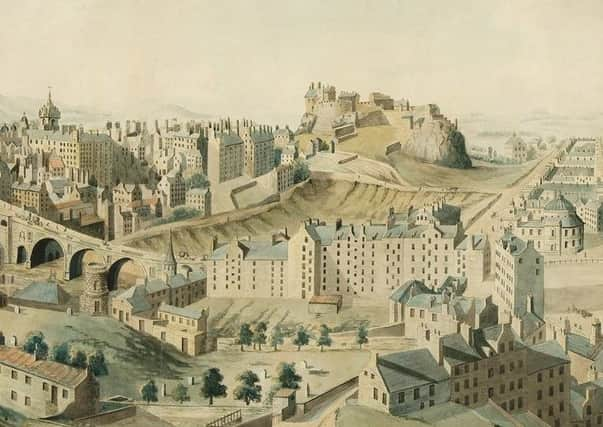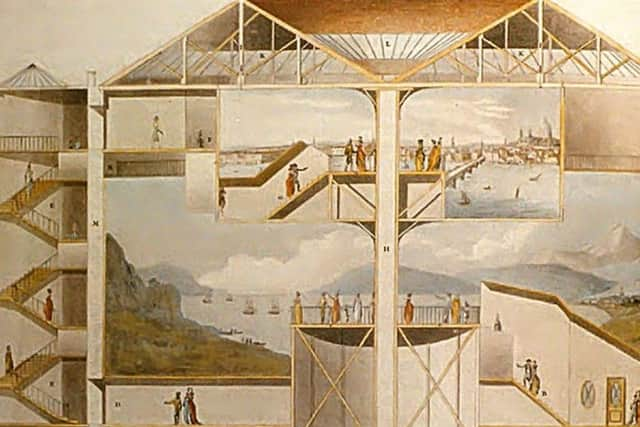Lost Edinburgh: Calton Hill and the invention of the panorama


When itinerant Irish painter Robert Barker moved to Edinburgh in the 1780s he did so in a bid to improve his fortunes. He could scarcely have imagined that the move would lead him to create one of the most popular and lucrative entertainment forms of the age.
Beginnings
Robert Barker was born in 1739 in County Meath, Ireland. A skilled artist by trade, he spent his early working life producing portraits and miniatures in Dublin.
Advertisement
Hide AdAdvertisement
Hide Ad

By the 1780s the Irishman had moved with his family to Edinburgh, working alongside British army officers who were keen to see if Barker’s acute understanding of perspective could be adopted for military use.
Inventing the panorama
Robert Barker was a master of perspective who had studied the wide-angle urban views of Renaissance and baroque landscape paintings for much of his life.
History has it that it was during a visit to Calton Hill one day in 1787 Barker came up with the idea of the panorama. Using some self-designed apparatus, the artist enlisted the help of his 12-year-old son, Henry, to sketch out a 360 degree view of Edinburgh from the hilltop.


With a little monetary assistance courtesy of his pals in the military, Barker was able to complete a large format semi-circular watercolour view from his son’s sketches. The paintings were large enough to fill a small debating chamber.
As if that wasn’t enough, Barker then coined a term which is today recognised the world over. By meshing together the Greek words ‘pano’ (all) and ‘horama’ (view), Barker had conceived the definitive term to describe what he had created. In June 1787 a patent was filed.
• READ MORE: Lost Edinburgh: The Palais de danse
First public exhibition
The panorama was first exhibited to the public in early 1788 at Archers’ Hall near the Meadows. Its unveiling was well-attended and attracted rave reviews. As a form of public entertainment it was quickly becoming clear that Barker’s panoramic views possessed huge commercial potential.
Barker and his young son soon found themselves down in London exhibiting a new, even bigger panorama at a purpose built venue at Leicester Square. The visitor would enter a lit chamber within a wooden rotunda where they would encounter a full 360 degree landscape measuring from ceiling to floor.
Advertisement
Hide AdAdvertisement
Hide AdThe panorama was designed to be a wholly immersive experience. It was the Regency era’s attempt at dabbling in virtual reality and it would make Robert Barker an immensely rich and influential man.
Legacy
In the years which followed Robert Barker’s death in 1806, panorama-mania swept the country and further afield. Technology advanced fast and by 1809 the first moving panorama, also launched in Edinburgh, was unveiled.
The popularity of the panorama continued. Scenes from distant conflicts wowed audiences from France to the United States. Barker’s son Henry even forged close personal ties with the famous military leader and panorama fan Napoleon Bonaparte.
The diorama, a blood relative of the panorama, also proved vastly popular during the 1800s. It was similar in concept to Barker’s creation, except that the audience remained seated while the scenery moved for them. Lighting effects were later added to simulate the passage of time. In Edinburgh, elaborate dioramas were shown up until the middle of the 19th century at the Rotunda on the Mound.
The first photographic panoramas arrived in the 1840s hot on the heels of the invention of photography itself. They have remained popular ever since, and the ability to create a panorama is a standard function of most modern smartphones or digital cameras.
Virtual reality
Since March of last year immersive 360 degree video panoramas allowing free user orientation have proved to be a big hit on YouTube. Much like the audiences of Robert Barker’s time, we remain a society obsessed with the pursuit of virtual reality.
While we’re still a long way off from stepping into the holodeck imagined by the creators of Star Trek: The Next Generation; recent advancements in VR technology suggest that it’s merely a matter of time before fiction is turned into fact.
Advertisement
Hide AdAdvertisement
Hide AdIn the meantime we doff our caps to Robert Barker and his Edinburgh-inspired creation which played a big part in kick-starting it all more than two centuries ago.
Robert Barker’s early panoramas of Calton Hill can be viewed on the Capital Collections website run by Edinburgh Libraries.